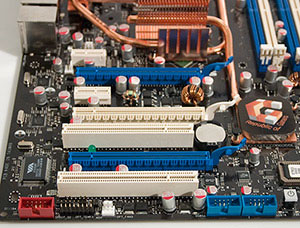Asus Striker Extreme Nvidia nForce 680i Motherboard
Motherboard Layout (Cont.)
Layout Continued
Because it's based on the nForce 680i SLI chipset, it's no surprise that the board fully supports Nvidia's SLI multi-GPU technology. The board is equipped with dual PCI Express x16 graphics card slots (in blue), which provide full bandwidth to the graphics cards. The 680i takes PCI Express connectivity one bit further though with an additional PCI Express x16 slot between the two blue slots. This slot is only connected to eight PCI Express lanes, but can handle full-sized PCI Express x16 sized cards (say, for example, another graphics card).
For those thinking that this will make for some sort of Tri-SLI configuration, think again. There's currently no method for connecting three cards together in a multi-GPU configuration. However, a third graphics card could be installed in here to provide additional monitor outputs or physics support. Consider that both ATI and Nvidia have PCIe cards which can handle two outputs per card. Three of these PCIe cards could mean six native PCI Express connected monitor links on one system - without much hassle. The board also supports a single PCI Express x1 connector and two 32-bit PCI connectors as well, keeping a fairly good mix of new and older connectors.

Expansion Slots |

Serial ATA Ports |
The nForce 680i chipset supports six Serial ATA-II/300 ports natively, and Asus has mounted the ports in a ninety degree fashion in order to allow the cables to not interfere with expansion cards installed above the slots. The ports support RAID as well, like prior Nvidia chipsets, allowing for RAID 0, 1, 0+1, and 5 support. Nvidia has had some troubles with data corruption on other nForce 680i platforms, but the Striker Extreme has so far not been affected by these issues, as this board was designed by Asus and does not use Nvidia's reference design. The board also has one floppy connector and one IDE port (supporting up to two drives). Surprisingly, even with the high end focus of this motherboard, Asus does not include rounded IDE/floppy cables with the Striker. eVGA bundles some very nice rounded cables with their 680i board, so we would expect this from a more expensive 680i platform. Alas, Asus still bundles their same old ribbon cables with the Striker.
Separate from the Nvidia SATA ports, there is a Silicon Image SATA-II controller which sits near the I/O panel, which allows for dual eSATA port connectivity, a first we've seen thus far. As eSATA drives are becoming more widely available, we're glad to see additional eSATA connectivity for a high-end board such as this. The Silicon Image 3132 controller which is used connects directly to a PCI Express x1 link.
Above the top PCI Express x16 connector on the motherboard is Asus' audio riser card slot, which utilizes the bundled "SupremeFX" output card, which is unfortunately not compatible with any other cards - so this slot is more or less useless for other expansion purposes. The SupremeFX card is a small riser card which holds the analog outputs for the onboard HD audio for the Striker Extreme. The SupremeFX card holds the CODEC (Analog Devices 1988B) as well, although the digital ports remain on the main I/O panel. Daughter boards such as this are typically designed to isolate noise away from the rest of the system - although it's likely more due to that the Striker's I/O panel is already stuffed with ports, moving the analog ports to an optional side card makes spacing things out a little easier. The board also comes with a small SoundMax microphone unit which can be mounted easily on one's desk or monitor.

Soundmax Mic and SupremeFX Card






